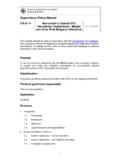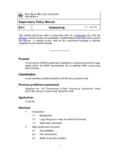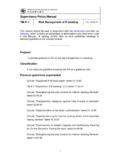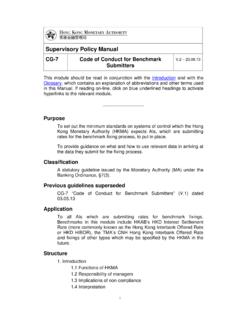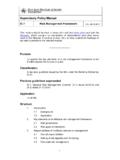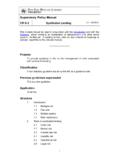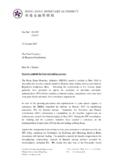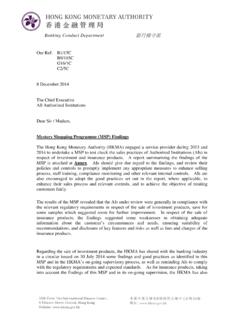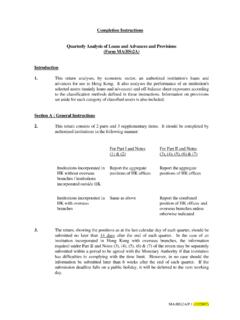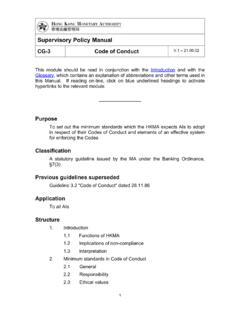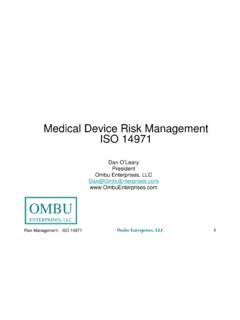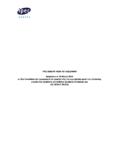Transcription of Supervisory Policy Manual - Hong Kong Monetary …
1 Supervisory Policy Manual IC-5 Stress-testing 1 This module should be read in conjunction with the Introduction and with the Glossary, which contains an explanation of abbreviations and other terms used in this Manual . If reading on-line, click on blue underlined headings to activate hyperlinks to the relevant module. Purpose To provide guidance to AIs on the key elements of an effective stress-testing programme, and describe the HKMA s Supervisory approach to assessing the adequacy of their stress-testing practices Classification A non-statutory guideline issued by the MA as a guidance note Previous guidelines superseded IC-5 Stress-testing ( ) dated Application To all AIs Structure 1.
2 Introduction Background Main functions of stress-testing Scope and coverage Application Implementation 2. Stress-testing programme General Process, policies and procedures Governance and infrastructure Supervisory Policy Manual IC-5 Stress-testing 2 Stress-testing approaches, methodologies and techniques Design and setting of stress scenarios Use of stress-testing results and risk-mitigating strategies Interpretation and communication of stress-testing results Independent review of stress-testing programme 3. Risk factors and stress scenarios General Identification of risk factors Types of stress scenarios 4. Supervisory assessment of stress-testing practices General Assessment approach Use of Supervisory scenarios Supervisory Policy Manual IC-5 Stress-testing 3 1.
3 Introduction Background Stress-testing involves the use of various techniques to assess a financial institution s potential vulnerability (typically in terms of its profitability, liquidity and capital adequacy) to stressed business conditions and thereby plays an important role in the management of risk by banks. It is also a tool commonly employed by supervisors for assessing the risks and vulnerabilities within banking systems. Examples of extreme market movements and crises in the past show that it is inadequate to manage risks only on the basis of normal business conditions. When hit by a severe market shock, banks may incur substantial losses as a result of one or more of the following circumstances: assumptions of how markets behave during normal conditions no longer hold true and risk characteristics change rapidly as market events unfold, making certain historical statistical relationships (such as correlations), and thus banks risk management models that build on these relationships, unreliable; new concentrations of risk emerge through unexpected linkages between different markets, risk types and positions.
4 Initial shocks may be dramatically amplified and spill over to other market segments, as reactions by market participants can induce feedback effects and lead to system-wide interactions; market prices may become highly volatile, and a squeeze in liquidity across multiple markets may occur and may last for a prolonged period of time; economic conditions may suddenly deteriorate in affected countries or regions; impairment or closure of foreign exchange swap markets may render it impossible to exchange one currency for another; or Supervisory Policy Manual IC-5 Stress-testing 4 difficulties in unwinding or hedging positions may be experienced as participants scramble to exit the market simultaneously, thereby drying-up market liquidity and heightening concern over counterparty credit risk.
5 The above should serve to illustrate the importance of employing stress-testing techniques to estimate an AI s likely losses under adverse conditions, and to enable the AI to be better prepared for such situations. Main functions of stress-testing Stress-testing is an essential risk management tool for AIs. It helps alert AIs management to adverse unexpected outcomes related to a variety of risks to which AIs are exposed, and provides an indication of the amount of financial resources (including capital and liquidity) that might be necessary to absorb losses caused by, or to withstand, severe stressed conditions. Stress-testing, in particular, serves the following purposes: providing a forward-looking assessment of an AI s risk exposures under stressed conditions and enabling the AI to develop appropriate risk-mitigating strategies ( restructuring positions) and contingency plans across a range of stressed conditions; improving the AI s understanding of its own risk profile and facilitating its monitoring of changes in such profile over time; informing the Board1 and senior management on the setting of the AI s risk appetite or tolerance and the determination of whether its risk exposures are commensurate with the stated risk appetite or tolerance.
6 1 In this module, the term Board refers to the Board of Directors of a locally incorporated AI or, in the case of an AI incorporated outside Hong Kong, its Board of Directors and/or regional or local management as appropriate. Supervisory Policy Manual IC-5 Stress-testing 5 supplementing the use of statistical risk measures ( value-at-risk or economic capital models) which are based mainly on historical data and assumptions, and contributing to the modelling of the risks associated with new products or activities where there is a lack of sufficient historical data. Stress-testing helps quantify tail risk ( the risk of losses under extreme market conditions) and re-assessment of modelling assumptions ( those in relation to volatility and correlation); evaluating the AI s existing and potential vulnerabilities on a firm-wide basis2 ( emerging risk concentrations) and its capacity to withstand stressed situations in terms of profitability, liquidity and capital adequacy; feeding into the AI s capital and liquidity planning and strategic decision-making processes.
7 And supporting internal and external communication regarding the AI s risk appetite or tolerance, risk exposures, and risk-mitigating strategies. Scope and coverage This module sets out key elements of an effective stress-testing programme and explains the HKMA s expectations with regard to AIs stress-testing practices. Within this context, stress-testing refers not only to the mechanics of applying specific stress tests for risk management purposes, but also to the wider environment within which the tests are developed, evaluated and used to assist in an AI s decision-making processes. This module draws principally on (i) the Principles for sound stress testing practices and supervision issued by the Basel Committee on Banking Supervision in May 2009; (ii) the HKMA s relevant Supervisory practices and experience; and (iii) recommendations and observations 2 For a banking group, the concept of firm-wide risk management will similarly apply on a group-wide basis, through managing the relevant risks of the parent bank and its group entities as a whole.
8 Supervisory Policy Manual IC-5 Stress-testing 6 made by other international organisations and industry groups to address weaknesses in banks stress-testing practices revealed by the 2008/09 Global Financial Crisis. These weaknesses include inadequate Board and senior management oversight of the stress-testing process; under-estimation of the potential severity and duration of stress events; inadequate account taken of system-wide interactions and feedback effects caused by market reactions to stressed conditions; insufficient identification and aggregation of risks on a firm-wide basis; various limitations associated with stress-testing models and methodologies ( inability to change stress scenarios flexibly in response to a rapidly evolving environment, and breakdown of statistical relationships in times of stress).
9 And inadequate coverage of risks arising from complex structured products, pipeline or securitization risk, counterparty credit risk, contingent risks and funding liquidity risk. This module should be read in conjunction with IC-1 General Risk Management Controls . More specific guidance on the use of stress tests, such as that for the purposes of assessing the adequacy of regulatory capital and liquidity positions, and for the management of specific risk types, is contained in other modules, including - CA-G-3 Use of Internal Models Approach to Calculate Market Risk ; CA-G-4 Validating Risk Rating Systems under the IRB Approaches ; CA-G-5 Supervisory Review Process ; CR-G-1 General Principles of Credit Risk Management ; Supervisory Policy Manual IC-5 Stress-testing 7 CR-G-5 Country Risk Management ; CR-G-8 Large Exposures and Risk Concentrations.
10 CR-G-13 Counterparty Credit Risk Management ; IR-1 Interest Rate Risk Management ; LM-2 Sound Systems and Controls for Liquidity Risk Management ; RR-1 Reputation Risk Management ; SR-1 Strategic Risk Management ; TA-1 Market Risk Management ;3 and TA-2 Foreign Exchange Risk Management . Application The guidance set out in this module applies to all AIs. The HKMA will adopt a proportionate approach when assessing AIs stress-testing programmes, having regard to the nature, scale and complexity of their business activities and the risks associated with those activities. AIs with small and simple operations which undertake and pose relatively less risk will not be expected to have a stress-testing programme that is as elaborate and sophisticated as those with more complex operations which undertake and pose more risk.
